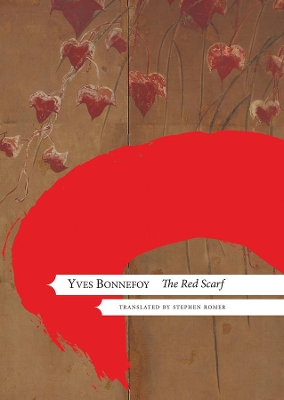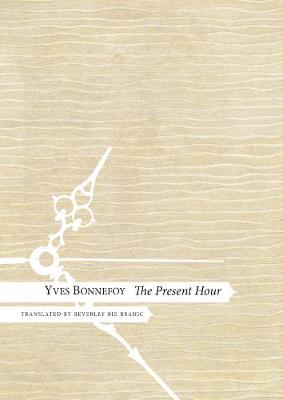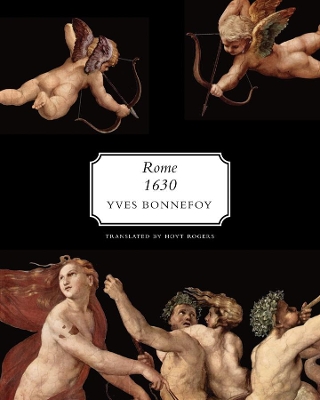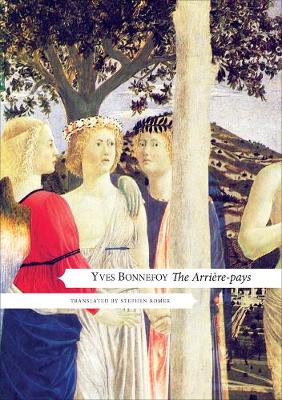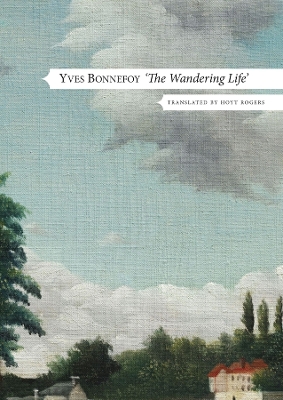French List
6 total works
An intensely personal and profoundly moving review of Bonnefoy’s childhood memories.
In December 2015, six months before his death at the age of 93, Yves Bonnefoy concluded what was to be his last major text in prose, L’écharpe rouge, translated here as The Red Scarf. In this unique book, described by the poet as "an anamnesis"—a formal act of commemoration—Bonnefoy undertakes, at the end of his life, a profoundly moving exegesis of some fragments written in 1964. These fragments lead him back to an unspoken, lifelong anxiety: “My most troubling memory, when I was between ten and twelve years old, concerns my father, and my anxiety about his silence.” Bonnefoy offers an anatomy of his father’s silence, and of the melancholy that seemed to take hold some years into his marriage to the poet’s mother.
At the heart of this book is the ballad of Elie and Hélène, the poet’s parents. It is the story of their lives together in the Auvergne, and later in Tours, seen through the eyes of their son—the solitary boy’s intense but inchoate experience, reviewed through memories of the now elderly man. What makes The Red Scarf indispensable is the intensely personal nature of the material, casting its slant light, a setting sun, on all that has gone before.
In December 2015, six months before his death at the age of 93, Yves Bonnefoy concluded what was to be his last major text in prose, L’écharpe rouge, translated here as The Red Scarf. In this unique book, described by the poet as "an anamnesis"—a formal act of commemoration—Bonnefoy undertakes, at the end of his life, a profoundly moving exegesis of some fragments written in 1964. These fragments lead him back to an unspoken, lifelong anxiety: “My most troubling memory, when I was between ten and twelve years old, concerns my father, and my anxiety about his silence.” Bonnefoy offers an anatomy of his father’s silence, and of the melancholy that seemed to take hold some years into his marriage to the poet’s mother.
At the heart of this book is the ballad of Elie and Hélène, the poet’s parents. It is the story of their lives together in the Auvergne, and later in Tours, seen through the eyes of their son—the solitary boy’s intense but inchoate experience, reviewed through memories of the now elderly man. What makes The Red Scarf indispensable is the intensely personal nature of the material, casting its slant light, a setting sun, on all that has gone before.
From the publication of his first book in 1953, Yves Bonnefoy has been considered the most important and influential French poet since World War II. A prolific writer, critic, and translator, Bonnefoy continues to compose groundbreaking new work sixty years later, constantly offering his readers what Paul Auster has called "the highest level of artistic excellence." In The Present Hour, Bonnefoy's latest collection, a personal narrative surfaces in splinters and shards. Every word from Bonnefoy is multifaceted, like the fragmented figures seen from different angles in cubist painting-as befits a poet who has written extensively about artists such as Goya, Picasso, Braque, and Gris. Throughout this moving collection, Bonnefoy's poems echo each other, returning to and elaborating upon key images, thoughts, feelings, and people. Intriguing and enigmatic, this mixture of sonnet sequences and prose poems - or, as Bonnefoy sees them, "dream texts" - moves from his meditations on friendship and friends like Jorge Luis Borges to a long, discursive work in free verse that is a reflection on his thought and process.
These poems are the ultimate condensation of Bonnefoy's life in writing, and they will be a valuable addition to the canon of his writings available in English.
These poems are the ultimate condensation of Bonnefoy's life in writing, and they will be a valuable addition to the canon of his writings available in English.
Velazquez. Poussin. Carvaggio. Bernini. Despite their disparate backgrounds, these greats of European Baroque art converged at one remarkable place in time: Rome, 1630. In response to the Protestant Reformation, the Catholic Church turned to these masters of Baroque art to craft works celebrating the glories of the heavens manifested on earth. And so, with glittering monuments like Bernini’s imposing bronze columns in St. Peter’s Basilica, Rome, 1630 came to be the crossroads of seventeenth-century art, religion, and power.
In Rome, 1630, the renowned French poet and critic Yves Bonnefoy devotes his attention to this single year in the Baroque period in European art. Richly illustrated with artwork that reveals the unique, yet instructive, place of Rome in 1630 in European art history, Bonnefoy dives deep into this transformative movement. The inclusion of five additional essays on seventeenth-century art situate Bonnefoy’s analysis within a lively debate on Baroque art and art history. Translator Hoyt Rogers's afterword pays homage to the author himself, situating Rome, 1630 in Bonnefoy’s productive career as a premier French poet and critic.
In Rome, 1630, the renowned French poet and critic Yves Bonnefoy devotes his attention to this single year in the Baroque period in European art. Richly illustrated with artwork that reveals the unique, yet instructive, place of Rome in 1630 in European art history, Bonnefoy dives deep into this transformative movement. The inclusion of five additional essays on seventeenth-century art situate Bonnefoy’s analysis within a lively debate on Baroque art and art history. Translator Hoyt Rogers's afterword pays homage to the author himself, situating Rome, 1630 in Bonnefoy’s productive career as a premier French poet and critic.
Praised by Paul Auster as "one of the rare poets in the history of literature to have sustained the highest level of artistic excellence throughout an entire lifetime," Yves Bonnefoy is widely considered the foremost French poet of his generation. Proving that his prose is just as lyrical, Rue Traversiere, written in 1977, is one of his most harmonious works. Each of the fifteen discrete or linked texts, whose lengths range from brief notations to long, intense, self-questioning pages, is a work of art in its own right: brief and richly suggestive as haiku, or long and intricately wrought in syntax and thought; and all are as rewarding in their sounds and rhythms, and their lightning flashes of insight, as any sonnet. "I can write all I like; I am also the person who looks at the map of the city of his childhood, and doesn't understand," says the section that gives the book its title, as he revisits childhood cityscapes and explores the tricks memory plays on us.
A mixture of genres - the prose poem, the personal essay, quasi-philosophical reflections on time, memory, and art - this is a book of both epigrammatic concision and dreamlike narratives that meander with the poet's thought as he struggles to understand and express some of the undercurrents of human life. The book's layered texts echo and elaborate on one another, as well as on aspects of Bonnefoy's own poetics and thought.
A mixture of genres - the prose poem, the personal essay, quasi-philosophical reflections on time, memory, and art - this is a book of both epigrammatic concision and dreamlike narratives that meander with the poet's thought as he struggles to understand and express some of the undercurrents of human life. The book's layered texts echo and elaborate on one another, as well as on aspects of Bonnefoy's own poetics and thought.
Since the publication of his first book in 1953, Yves Bonnefoy has become one of the most important French poets of the postwar years. At last, we have the long-awaited English translation of his celebrated work "L'Arriere-Pays", which takes us to the heart of his creative process and to the very core of his poetic spirit. In his poem "The Convex Mirror," Bonnefoy writes: "Look at them down there, at that crossroads, / They seem to hesitate, then go on." The idea of the crossroads haunts Bonnefoy's work, as he is troubled by the idea that the path not taken may lead to the arriere-pays, a place of greater plenitude, and of more authentic being - an "elsewhere in the absolute." Seized by this fear that what he terms "presence" exists always somewhere else, a little further on, Bonnefoy here sets out on a labyrinthine quest to find traces of this "original place," which he locates not only in objects of knowledge and experience as diverse as the deserts of Asia, a hill fort in India, a church in Armenia, and the paintings of Piero della Francesca but also, crucially, in the undivided intensity of his experiences as a child.
Written with a visionary grace, "The Arriere-Pays" is a spiritual testament to art, philosophy, and poetry. Enriched by a new preface by the poet, this volume also includes three recent essays in which he returns to his original account of an ethical and aesthetic haunting, one that recounts the struggle between our instinct to idealize - what he deems our eternal Platonism - and the equally strong need to combat this and to be reconciled with our nature as finite beings, made of flesh and blood, in the world of the here and now.
Written with a visionary grace, "The Arriere-Pays" is a spiritual testament to art, philosophy, and poetry. Enriched by a new preface by the poet, this volume also includes three recent essays in which he returns to his original account of an ethical and aesthetic haunting, one that recounts the struggle between our instinct to idealize - what he deems our eternal Platonism - and the equally strong need to combat this and to be reconciled with our nature as finite beings, made of flesh and blood, in the world of the here and now.
The first English translation of Yves Bonnefoy’s account of his life as a traveler.
The Wandering Life is a poetic culmination of Yves Bonnefoy’s wanderings and characterizes the final twenty-five years of his work. Bonnefoy was an ardent traveler throughout his life, and his journeys in foreign countries left a profound imprint on his work. The time he spent in Italy, translating Shakespeare’s work in England, in universities in the United States, in India with Octavio Paz, and more, affected his poetry in discernible ways and inspired The Wandering Life. Interweaving verse and prose—vignettes that range from a few lines in length to several pages—this volume is a fitting capstone to Bonnefoy’s oeuvre and appears in English translation for the first time to mark the centenary of Yves Bonnefoy’s birth.
The Wandering Life is a poetic culmination of Yves Bonnefoy’s wanderings and characterizes the final twenty-five years of his work. Bonnefoy was an ardent traveler throughout his life, and his journeys in foreign countries left a profound imprint on his work. The time he spent in Italy, translating Shakespeare’s work in England, in universities in the United States, in India with Octavio Paz, and more, affected his poetry in discernible ways and inspired The Wandering Life. Interweaving verse and prose—vignettes that range from a few lines in length to several pages—this volume is a fitting capstone to Bonnefoy’s oeuvre and appears in English translation for the first time to mark the centenary of Yves Bonnefoy’s birth.
